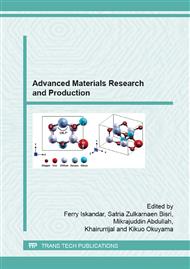p.3
p.7
p.11
p.15
p.19
p.23
p.27
p.32
Optical Band Transitions and Excitonic States in ZnO:Cu Films
Abstract:
Photoluminescence (PL), ultraviolet-visible (UV-VIS) absorption spectroscopy and spectroscopic ellipsometry (SE) are combining to study the optical transitions and electronic structures of Cu doped ZnO films with Cu concentration of 0, 2 and 8 at. %. By increasing Cu concentration, PL spectra show the enhancement of optical transition through the significantly increase of the green emission. Correspondingly, the in-plane UV visible absorption spectra show the redshift of first interband transition as the evidence of ZnO film become less insulating. More interestingly, extracted optical properties such as n and k clearly shows the mid-gap optical states, interband transitions and excitons. The excitonic peak decrease by increasing Cu concentration accompanied by a new broad structure assigned as a mid-gap state located under the conduction band area. Excitonic states are screened as decreasing its intensities by increasing Cu doping. Our results are beneficial to define interband transition and explain the mid-gap state in the oxide based semiconductor.
Info:
Periodical:
Pages:
3-6
Citation:
Online since:
July 2015
Authors:
Keywords:
Price:
Сopyright:
© 2015 Trans Tech Publications Ltd. All Rights Reserved
Share:
Citation:


